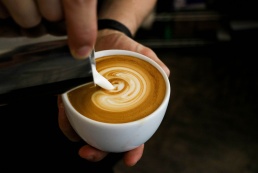How much of a coffee connoisseur are you? Did you know:
- We drink around 500 billion cups of coffee each year and, as a commodity, the tiny coffee bean ranks second to petroleum in terms of dollars traded worldwide. As an industry coffee employs 25 million people worldwide.
- Brazil, the largest coffee producer in the world giving us around a third of the coffee consumed, grows nearly twice as much coffee as Vietnam, the second largest producer. Coffee is currently grown in more than 70 countries mainly in Africa, South Asia, Southeast Asia, and Latin America.
- Legend has it that coffee was first discovered as a drink in Abyssinia (now Ethiopia) in around 850AD. A goat herder, Khaldi, noticed that his goats became excitable and jolly appearing to dance after munching on some red berries from an evergreen bush. He took the berries to a local monk who made a drink with the bounty. It kept him awake that night which only emphasised its superpowers.
- Coffee trees were first cultivated on the Arabian Peninsula, where people typically roasted and boiled coffee, or qahwa, “the wine of Islam.” It’s widely thought that the word ‘qahwa’ evolved into kahveh in Turkish, and then koffie in Dutch, which is where we get the English word coffee, but equally possible that it evolved directly from Kaffa, the region in Ethiopia where coffee is thought to have originated.

- It takes 3 to 4 years for a coffee tree to mature. Once it matures, each tree will bear between a half and full kilo of coffee beans per growing season.
- Coffee beans are technically seeds. They are the pits of berries that look very like cherries that appear on flowering coffee shrubs. We’ve taken to calling them beans as they look similar to legumes. The berries can be eaten and in the past have been used to create energy-rich snack balls and fermented to make an alcoholic wine style drink.
- Light roast coffee has more caffeine than dark roast coffee as the longer coffee is roasted the more caffeine is cooked from the bean. More interesting is the reason why coffee contains caffeine. Not only is it toxic to slugs and other pests helping to protect the plants and fruit, but caffeine has a converse effect on pollinators such as bees who get a buzz from the caffeine in the plant’s flowers. Scientists have found that consuming caffeine helps bees improve their long-term memories. It makes the flowers more memorable which means that the bees are more likely to return and pollinate the plants again.
- This buzz has had many leaders trying to ban coffee over the years. Coffee was banned in Mecca between 1511 and 1524 as it was believed to stimulate radical thinking and hanging out. Later, in the 16th century Pope Clement VII was urged to ban coffee by some of his advisors who called it the ‘devil’s beverage’ After tasting it himself he is reported to have commented that it was ‘so delicious that it would be a sin to let only misbelievers drink it” and to have even blessed it. In the UK, coffee made its first appearance in1652 and by 1675 there were more than 3,000 coffee houses, 82 of which were in London. But coffee wasn’t popular with everyone. A group of women, frustrated by the lack of virility in their men, claimed coffee “made men as unfruitful as the deserts.” Several thousand of these “Buxome Good-Women, Languishing in Extremity of Want,” petitioned King Charles II to ban coffee but others were very unhappy with this decision and the ban which had been passed on 29th December 1675 was abolished on 10th January 1676 two days before it was due to become active and coffee houses continued to thrive and as meeting places frequented by leading figures such as Isaac Newton, Robert Hooke, Samuel Johnson, and Alexander Pope. King Charles was not the last leader to attempt to ban coffee or even being indecisive about it, with the Swedish government banning coffee five times between 1756 and 1817.

- Although King Gustav III of Sweden believed that coffee shortened its drinker’s life span, recent evidence shows that moderate coffee drinkers (drinking up to 3-4 cups a day) tend to live longer, with a reduced risk of cardiovascular disease, type 2 diabetes and Parkinson’s. Not only that but they also have a decreased chance of developing Alzheimer’s disease and dementia. It is widely known now that coffee contains antioxidants, which helps prevent free radicals from damaging cells and one study has shown a typical 9oz serving of coffee contains more antioxidants than a serving of grape juice, blueberries, raspberries, or oranges.
- Coffee is not only a delicious and popular drink, coffee grounds can be used for a DIY beauty scrub lifting off dead skin cells and making skin feel smooth and look brighter. Research is currently taking place into its benefits on blood circulation in the skin. Before that is known, any additional remaining grounds can be used in the garden as a slug repellent.
Thinking back to my cappuccino earlier today, I remember that the link between coffee and region does not end with Muslim holy men making coffee a beverage in the 9th century or with Pope Clement VII. It is believed that the word cappuccino comes from the Capuchin friar, Marco d’Aviano, and the red-brown colour of his habit. Not surprisingly given its popularity around the world, coffee has had and continues to have a widespread and important role in all our lives.

